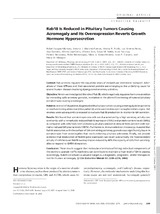Mostrar el registro sencillo del ítem
Rab18 is reduced in pituitary tumors cusing acromegaly and its overexpression reverts growth hormone hypersecretion
| dc.contributor.author | Vázquez Martínez, Rafael | |
| dc.contributor.author | Martínez-Fuentes, Antonio J. | |
| dc.contributor.author | Pulido, Marina R. | |
| dc.contributor.author | Jiménez Reina, L. | |
| dc.contributor.author | Quintero, Ana | |
| dc.contributor.author | Leal-Cerro, Alfonso | |
| dc.contributor.author | Soto, Alfonso | |
| dc.contributor.author | Webb, Susan M. | |
| dc.contributor.author | Sucunza, Nuria | |
| dc.contributor.author | Bartumeus, Frederic | |
| dc.contributor.author | Benito-López, Pedro | |
| dc.contributor.author | Galvez-Moreno, María A. | |
| dc.contributor.author | Castaño, Justo P. | |
| dc.contributor.author | Malagón, María M. | |
| dc.date.accessioned | 2024-01-26T07:58:31Z | |
| dc.date.available | 2024-01-26T07:58:31Z | |
| dc.date.issued | 2008 | |
| dc.identifier.issn | 1945-7197 | |
| dc.identifier.uri | http://hdl.handle.net/10396/26779 | |
| dc.description.abstract | Context: Rab proteins regulate the sequential steps of intracellular membrane transport. Alterations of these GTPases and their associated proteins are emerging as the underlying cause for several human diseases involving dysregulated secretory activities. Objective: Herein we investigated the role of Rab18, which negatively regulates hormone secretion by interacting with secretory granules, in relation to the altered functioning of tumoral pituitary somatotropes causing acromegaly. Patients: A total of 18 patients diagnosed with pituitary tumors causing acromegaly (nine patients) or nonfunctioning adenomas (nine patients) underwent endoscopic transsphenoidal surgery. Adenomas were subsequently processed to evaluate Rab18 production in relation to GH secretion. Results: We found that somatotropinoma cells are characterized by a high secretory activity concomitantly with a remarkably reduced Rab18 expression (15%) and protein content levels (30%), as compared with cells from nonfunctioning pituitary adenomas derived from patients with normal or reduced GH plasma levels (100%). Furthermore, immunoelectron microscopy revealed that Rab18 association with the surface of GH-containing secretory granules was significantly lower in somatotropes from acromegalies than nonfunctioning pituitary adenomas. Finally, we provide evidence that modulation of Rab18 gene expression can revert substantially the hypersecretory activity of cells because Rab18 overexpression reduced by 40% the capacity of cells from acromegalies to respond to GHRH stimulation. Conclusion: These results suggest that molecular alterations affecting individual components of the secretory granule traffic machinery can contribute to maintain a high level of GH in plasma. Accordingly, Rab18 constitutes a valuable target as a diagnostic, prognostic, and/or therapeutic tool for human acromegaly. | es_ES |
| dc.format.mimetype | application/pdf | es_ES |
| dc.language.iso | eng | es_ES |
| dc.publisher | Oxford Academic | es_ES |
| dc.rights | https://creativecommons.org/licenses/by/4.0/ | es_ES |
| dc.source | The Journal of Clinical Endocrinology & Metabolism, Volume 93, Issue 6,, pp 2269–2276 (2008) | es_ES |
| dc.subject | Rab proteins | es_ES |
| dc.subject | Human diseases | es_ES |
| dc.subject | Dysregulated secretory activities | es_ES |
| dc.subject | Rab18 | es_ES |
| dc.subject | Tumoral pituitary | es_ES |
| dc.subject | Somatotropinoma cells | es_ES |
| dc.title | Rab18 is reduced in pituitary tumors cusing acromegaly and its overexpression reverts growth hormone hypersecretion | es_ES |
| dc.type | info:eu-repo/semantics/article | es_ES |
| dc.relation.publisherversion | https://doi.org/10.1210/jc.2007-1893 | es_ES |
| dc.rights.accessRights | info:eu-repo/semantics/openAccess | es_ES |

